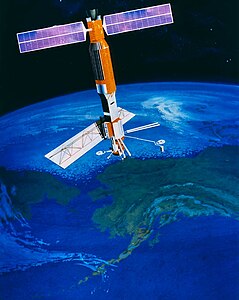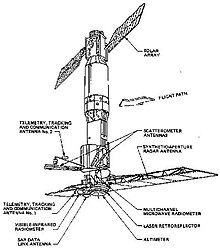Seasat
| Seasat | |
|---|---|

|
|
| Type: | Earth observation satellite |
| Country: |
|
| Operator: |
|
| COSPAR-ID : | 1978-064A |
| Mission dates | |
| Dimensions: | 2300 kg |
| Begin: | June 27, 1978, 1:12 UTC |
| Starting place: | Vandenberg SLC3-W |
| Launcher: | Atlas F / Agena D 23F |
| Status: | out of order since October 10, 1978 |
| Orbit data | |
| Rotation time : | 100.7 min |
| Orbit inclination : | 108 ° |
| Apogee height : | 799 km |
| Perigee height : | 769 km |
Seasat was the first Earth observation satellite of NASA for remote sensing of the seas. On June 27, 1978, the 2300 kg satellite was launched from Vandenberg Air Force Base with an Atlas Agena D into a 769 km × 799 km high orbit with an equatorial inclination of 108 °. It remained operational for only 105 days. The cause of the loss of the satellite on October 10, 1978 was a short circuit.
The Seasat, developed by the Jet Propulsion Laboratory , was intended to demonstrate the usability of technologies for earth exploration which until then had only been used for interplanetary space probes . The mission consisted of five experiments: a radar altimeter , a microwave scatterometer , a microwave radiometer , a radiometer in the range of visible and infrared light and, for the first time in an earth exploration satellite, a synthetic aperture radar (L-band, wavelength / frequency: 23.5 cm / 1.275 GHz) as the main instrument. This means that Seasat can be seen as a trailblazer for missions such as TOPEX / Poseidon , QuikSCAT or Jason . An improved version of the radar altimeter was launched on the Geosat satellite.
Results
Seasat discovered the canals under the Guatemalan jungle that allowed the Mayans to farm to supply their large cities. Seasat was also able to detect the waves generated by submerged submarines with its SAR radar.
See also
Web links
- Seasat with Bernd Leitenberger
- Information when eoPortal ESA (English)
- Brief information from JPL on Seasat ( Memento from July 14, 2012 in the Internet Archive )
- SeaSAT Atlas ( Memento from July 30, 2009 in the Internet Archive ) (PDF; 19 MB; English)
- Overview at JPL ( Memento from February 19, 2017 in the Internet Archive ) (English)
- Seasat on Gunter's Spage Page (English)
Individual evidence
- ↑ a b Seasat 1 in the NSSDCA Master Catalog , accessed on September 17, 2012 (English).
- ↑ SEASAT 1978. NASA, February 10, 1998 filed by the original on June 7, 2013 ; accessed on September 17, 2012 (English).
- ^ B. Stanek: Raumfahrtlexikon , Halwag Verlag, Bern (1983), ISBN 3-444-10288-7 page: 254-255
- ^ William J. Broad: US Loses Hold on Submarine-Exposing Radar Technique , New York Times, May 11, 1999.

